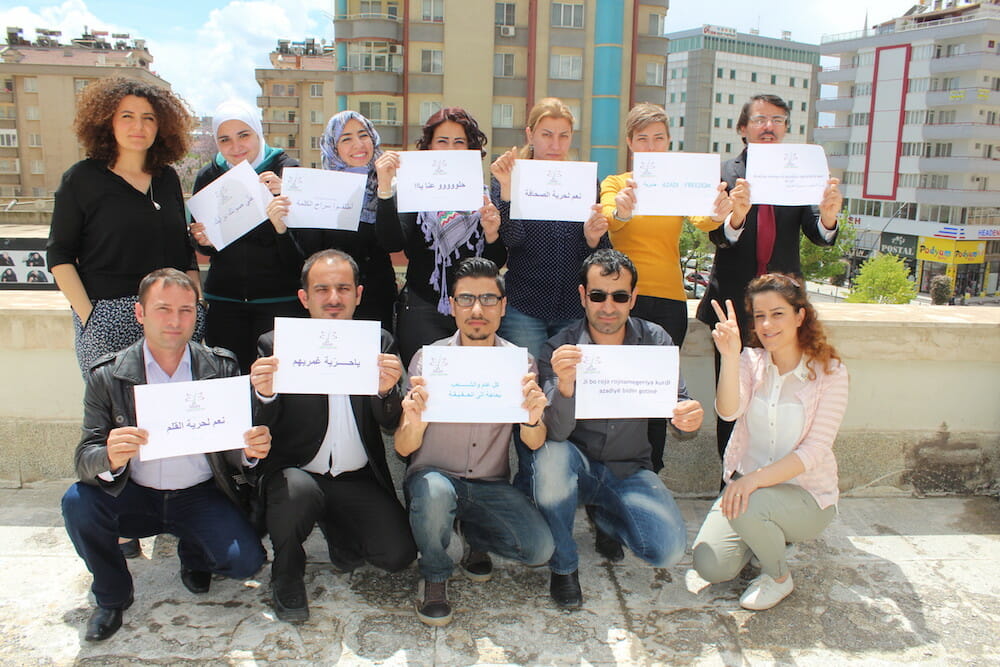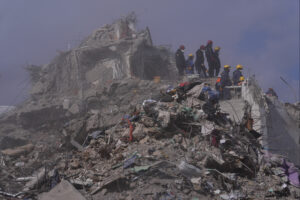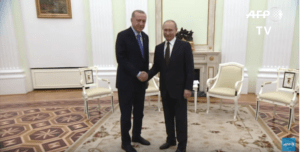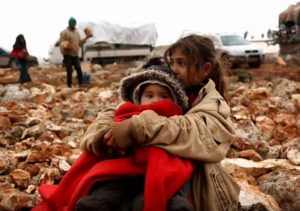Both Sides in Syrian Conflict Use Media to Stereotype Women
Regime media paints a modern, Western-friendly picture, while opposition media depicts women as passive and dependent. Emerging news outlets are trying to present a more accurate image. Members of the Syrian Female Journalists Network participate in a freedom-of-expression campaign by displaying messages such as "Free journalism" and "Raise your voice, share your opinions." The group works to connect media and the women's movement in Syria. (Syrian Female Journalists Network)
Members of the Syrian Female Journalists Network participate in a freedom-of-expression campaign by displaying messages such as "Free journalism" and "Raise your voice, share your opinions." The group works to connect media and the women's movement in Syria. (Syrian Female Journalists Network)
Truthdig is proud to present this article as part of its Global Voices: Truthdig Women Reporting, a series from a network of female correspondents around the world dedicated to pursuing truth within their countries and elsewhere.
During the seven years of the Syrian conflict, two very different depictions of women have developed in the state and opposition media, but critics say neither depiction reflects the realities of Syrian women’s lives. To fill that gap, news outlets are emerging to present women in a more accurate way.
State media, which supports the regime of President Bashar Assad, shows women in a secular light—often using models to represent outgoing, free and modern women. During the conflict, state media has begun depicting women in stronger social roles, although many call this coverage a propaganda ploy that ignores poor, marginalized women.
Meanwhile, the opposition media paints women as mothers—passive and dependent, wearing scarves. That media usually describes a woman in relation to her marriage, her husband or her “martyred” children.
However, media outlets have appeared that not only depict women in a balanced way but also work to support their rights and roles. These include Radio Souriat (Syrian Women’s Radio), which operates in regime-held areas, and Enab Baladi, an opposition newspaper.
State Media Portrayals
State media—and private media related to the regime—traditionally portrayed women in three ways: as wives and mothers; modern, outgoing women who worked mainly in art and media; or hardworking women in rural environments.
Although dozens of women worked in business, industry, law and even the military, women leaders were rarely seen in the Syrian media unless they were well-known personalities such as first lady Asma Assad or held official positions such as parliament membership.
After the Syrian uprising in March 2011, state media began to change some stereotypical images of Syrian women. While images of caring, loving women have continued to appear, state media now is apt to feature women in relation to the war. For example, it often focuses on the powerful woman who urges her sons to join the military to defend the country against terrorists.
Stories feature women overcoming wartime challenges by working in fields that are new to women in Syria—for example as waitresses or truck drivers. However, marginalized poor women rarely are seen on Syrian official media. Many say this reflects the general policy in the country of denying economic and social problems.
Since the war began, state media has concentrated on other new images as well: women as leaders—especially of programs designed to build skills during the war—and women fighters who have joined the Syrian army. Women are depicted as being empowered, open-minded and secular. This year for Mother’s Day, Asma Assad honored a group of women fighters along with their mothers. Her entire message at a reception she held was about strong Syrian women who are equal in power to Syrian men.
According to critics, the empowering image presented by regime media falls short—and constitutes propaganda rather than real reform. Laila, a Syrian freelance journalist who preferred to use a pseudonym for security reasons, says that in general women continue to be portrayed as dependents who can’t do anything without the help of a man.
“The stereotyping still persists, but what has changed is that the Syrian women’s voice has become louder, more organized and systematic, compared to a random voice before 2011,” Laila says. “I think that Syrian women are now more capable of knowing what channels to use and whom to coordinate with in order to make sure their voices are heard.”
Laila says that current state media coverage, including the increased reporting on presentation of the women leaders, serves propaganda goals because the regime is trying to showcase its secular pro-Western values in contrast to its opponents’ traditional values.
Laila also criticizes the regime’s focus on “cool,” active women who represent the modern face of the Syrian regime. “I am keen to show the Syrian woman as an independent human being,” she says. “She has her own dreams, capacities and needs. I have not faced direct objections, but I often hear comments from editorial boards such as ‘Why this coverage now? Who would listen or read it? Let us find more exciting examples of women.’ ‘Exciting’ here often means a modern, beautiful and unveiled woman.”

State media continues to present an inaccurate portrayal of women for several reasons, says Rula Asad of the Syrian Female Journalists Network (SFJN), which works to connect media and the women’s movement in Syria. Rula says editorial boards are often composed solely of men who perpetrate patriarchal attitudes, and news staff don’t learn how to deal fairly with gender issues in the media.
Opposition Coverage
Most of the Syrian opposition media either stereotypes women or neglects their stories, according to an SFJN report titled “Women in Emerging Syrian Media.” The study found coverage of women in opposition Syrian media included less than 200 articles between 2011 and 2016.
A good example is the opposition-controlled television station Aleppo Today. In a period of two months, from April to June 2018, only one of its videos showed women as active members of society. The footage featured a demonstration by women in a small town in northern Syria. The video covering the story was only 45 seconds long, well shy of the videos that focus on men; those commonly run at least two minutes.
Women were found to have rarely appeared on the popular Aleppo Today Facebook page. When they did, they usually were speaking about their marriages, their children, being the mother of a “martyr” or various iterations of these themes. Aleppo Today reported on a number of workshop events that taught women about things like governance, management and media, but even this reporting effort was flawed. All of the trainers, supervisors and judges distributing certificates to the shy, covered trainee women were men. Instead of questioning why there weren’t any women giving out certificates, the male reporter praised the efforts of the men. He insinuated that those efforts were a gift to women—not merely a small and necessary step taken in the direction of equality.
When Syrian women appear in the opposition media, they are mostly depicted as victims. They’re often standing in front of the camera screaming for help from anyone who will listen—the Arab states, Muslims around the world or the international community. The image of mothers who lost one or more sons is also dominant. If they are not victims or related to victims, women are often shown making handcrafts, a suitable job because it can be done at home without the need to go out and mix with men.
The SFJN report says most opposition media define women by their relationship to men—as sisters, daughters, mothers or wives. The report also points out false assumptions made by opposition media. These include: Women can’t fight; they are weak and incapable and require men’s help; women’s successes are due to their beauty, not their talent; and women belong in the private sphere taking care of the home and raising children, even if that home is in a refugee camp.
“Even when [opposition media is] covering stories about their courage or resilience, women tend to be highlighted as powerful because they coped without their dead men guardians,” SFJN Executive Director Asad says. “This kind of coverage of women is not poor only on the quantitative level, but it is also harmful on the qualitative level, as it serves only to reinforce gender biases and stereotypes.”
The representation of women in opposition photos and videos is also harmful, according to Rula Asad. If a woman is pictured in the center of an image, she is usually crying, hiding her face and not communicating with the audience. Otherwise she is in the background, “which implies that women’s role is minor,” Asad says.
Dr. Maya AlRahabi is a physician, pioneer Syrian feminist and co-founder of the Syrian Women’s Political Movement, which promotes gender equality. She takes issue with the conclusions of the SFJN report, saying: “It’s unfair to consider that the new media continued stereotyping women. Many journalists tried to break this after the uprising, and are still in constant contact with me and other feminists, trying to take our perspective on stories and channel our opinions to their audience.”
Dr. AlRahabi blames the stereotyping problem on an international patriarchal system that especially harms women in the developing nations—and that is much bigger than the Syrian media. She points to the United Nations as an example. It “pictures Syrian women as powerless victims without highlighting our active role inside Syria or neighboring countries where there are plenty of bright examples [of] … Syrian women’s work,” she says.
Emerging Media
Since the beginning of the war, media outlets with a mission to break down stereotypes and to support Syrian women have emerged in both regime and opposition territory.
Initially, the opposition newspaper Enab Baladi published articles filled with stereotypical images and language. However, it began to change noticeably in 2015, not only in the language it uses but also in the topics it covers relating to women.
“We [began to] cover the positive examples of women and showcase their success stories,” says Editor in Chief Jawad Sharbaji. “We don’t describe women in their relationship to a man—as the daughter of, wife, sister or mother. We care for gender balance when choosing our sources and experts, and we are cautious to avoid using stereotyping adjectives or specifying traditional gender roles.”
Sharbaji says the new policy emerged after the newspaper staff met with content consultants and attended international workshops on issues such as gender coverage and objective journalism. Also, in 2015 more women came to work at Enab Baladi.

Among other accomplishments, the staff published a series of articles about the positive and negative changes Syrian women experienced during the war. Enab Baladi also published videos and articles as part of a campaign celebrating “Women Defending Human Rights,” which launched on International Women’s Day 2017.
In regime-held territory, Radio Souriat is also dedicated to breaking down stereotypes about women. The station seeks to initiate change in Syrian society through community building, promoting the empowerment of women in public life and developing media discourse about gender issues.
Radio Souriat works to create an accurate image of Syrian women based on women’s needs and the station’s feminist agenda. “A Syrian woman can be a housewife, and also a public figure,” says Rana, a Radio Souriat staff member who uses a pseudonym for security reasons. “We cannot ignore any of her roles, and we try to focus on them all, beside supporting her in gaining all her social, economic and legal rights.”
Along with radio programing, Radio Souriat publishes videos on social media. One program portrayed Syrian women in new roles that cut through stereotypes—a singer, a young woman riding a bicycle, a woman working in public affairs. That became complicated because of social restrictions, Rana says. “Our society is still dominated by traditional … ways of thinking.” The singer, who performs in a veil, “was so worried and asked not to show her face or mention her full name, for fear of her family and society,” she says.
Rana summed up the barriers that slow progress when it comes to media portrayal of women. “It is not that easy to break down the taboos that dominate not only women but the whole Syrian society,” she says. “Syrian media is still in its first steps toward this. It still needs a lot of work in order to raise awareness inside the community about accepting others, and about the importance of women in all positions, including decision-making ones.”
Syrian journalist Alaa Youssef (a pseudonym used for security reasons in the war-torn country), a mentee in Truthdig’s Global Voices series, contributed to this article.
Your support matters…Independent journalism is under threat and overshadowed by heavily funded mainstream media.
You can help level the playing field. Become a member.
Your tax-deductible contribution keeps us digging beneath the headlines to give you thought-provoking, investigative reporting and analysis that unearths what's really happening- without compromise.
Give today to support our courageous, independent journalists.








You need to be a supporter to comment.
There are currently no responses to this article.
Be the first to respond.